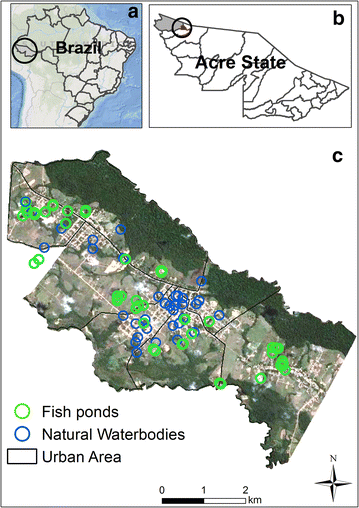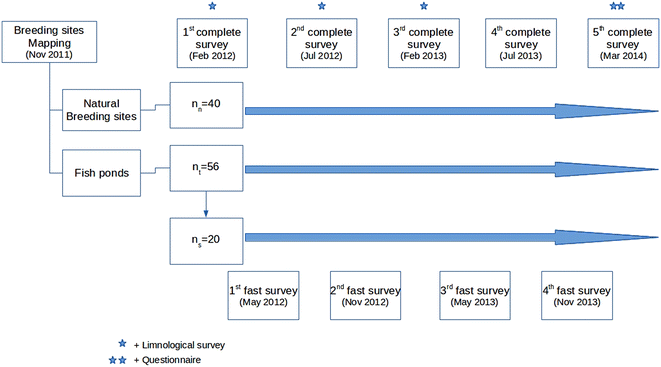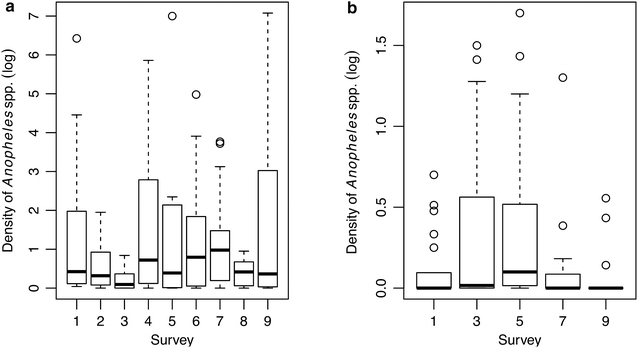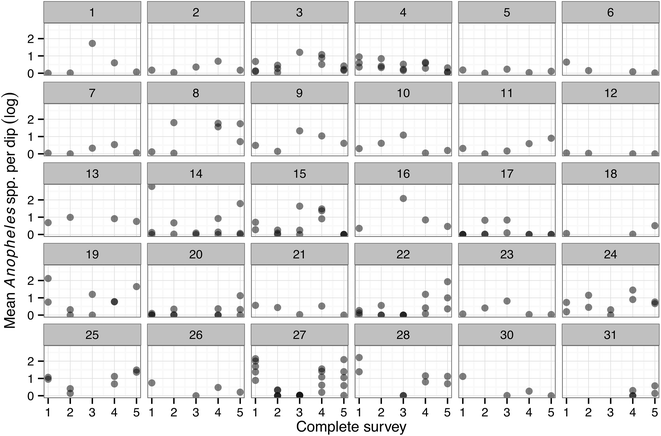Contribution of fish farming ponds to the production of immature Anopheles spp. in a malaria-endemic Amazonian town
- PMID: 26573145
- PMCID: PMC4647295
- DOI: 10.1186/s12936-015-0947-1
Contribution of fish farming ponds to the production of immature Anopheles spp. in a malaria-endemic Amazonian town
Abstract
Background: In the past decade fish farming has become an important economic activity in the Occidental Brazilian Amazon, where the number of new fish farms is rapidly increasing. One of the primary concerns with this phenomenon is the contribution of fishponds to the maintenance and increase of the anopheline mosquito population, and the subsequent increase in human malaria burden. This study reports the results of a 2-year anopheline abundance survey in fishponds and natural water bodies in a malaria-endemic area in northwest Brazil. The objective of this study was to investigate the contribution of natural water bodies (rivers, streams, creeks, ponds, and puddles) and artificial fishponds as breeding sites for Anopheles spp. in Mâncio Lima, Acre and to investigate the effect of limnological and environmental variables on Anopheles spp. larval abundance.
Methods: Natural water bodies and fishponds were sampled at eight different times over 2 years (early, mid and late rainy season, dry season) in the Amazonian town of Mâncio Lima, Acre. Anopheline larvae were collected with an entomological dipper, and physical, chemical and ecological characteristics of each water body were measured. Management practices of fishpond owners were ascertained with a systematic questionnaire.
Results: Fishponds were four times more infested with anopheline larvae than natural water bodies. Electrical conductivity and the distance to the nearest house were both significant inverse predictors of larval abundance in natural water bodies. The density of larvae in fishponds raised with increasing border vegetation. Fishponds owned by different farmers varied in the extent of anopheline larval infestation but ponds owned by the same individual had similar infestation patterns over time. Commercial fishponds were 1.7-times more infested with anopheline larvae compared to fishponds for family use.
Conclusions: These results suggest that fishponds are important breeding sites for anopheline larvae, and that adequate management activities, such as removal of border vegetation could reduce the abundance of mosquito larvae, most importantly Anopheles darlingi.
Figures





Similar articles
-
Ecology and larval population dynamics of the primary malaria vector Nyssorhynchus darlingi in a high transmission setting dominated by fish farming in western Amazonian Brazil.PLoS One. 2021 Apr 8;16(4):e0246215. doi: 10.1371/journal.pone.0246215. eCollection 2021. PLoS One. 2021. PMID: 33831004 Free PMC article.
-
Bionomics and population dynamics of anopheline larvae from an area dominated by fish farming tanks in northern Brazilian Amazon.PLoS One. 2023 Aug 25;18(8):e0288983. doi: 10.1371/journal.pone.0288983. eCollection 2023. PLoS One. 2023. PMID: 37624846 Free PMC article.
-
Monthly biological larviciding associated with a tenfold decrease in larval density in fish farming ponds and reduced community-wide malaria incidence in northwestern Brazil.Parasit Vectors. 2021 Sep 3;14(1):445. doi: 10.1186/s13071-021-04964-3. Parasit Vectors. 2021. PMID: 34479606 Free PMC article.
-
Environmental variables associated with anopheline larvae distribution and abundance in Yanomami villages within unaltered areas of the Brazilian Amazon.Parasit Vectors. 2017 Nov 16;10(1):571. doi: 10.1186/s13071-017-2517-6. Parasit Vectors. 2017. PMID: 29145867 Free PMC article.
-
Epidemic and Endemic Malaria Transmission Related to Fish Farming Ponds in the Amazon Frontier.PLoS One. 2015 Sep 11;10(9):e0137521. doi: 10.1371/journal.pone.0137521. eCollection 2015. PLoS One. 2015. PMID: 26361330 Free PMC article.
Cited by
-
The Hidden Burden of Plasmodium vivax Malaria in Pregnancy in the Amazon: An Observational Study in Northwestern Brazil.Am J Trop Med Hyg. 2018 Jul;99(1):73-83. doi: 10.4269/ajtmh.18-0135. Epub 2018 May 3. Am J Trop Med Hyg. 2018. PMID: 29741155 Free PMC article.
-
Ecology and larval population dynamics of the primary malaria vector Nyssorhynchus darlingi in a high transmission setting dominated by fish farming in western Amazonian Brazil.PLoS One. 2021 Apr 8;16(4):e0246215. doi: 10.1371/journal.pone.0246215. eCollection 2021. PLoS One. 2021. PMID: 33831004 Free PMC article.
-
Socioeconomic and demographic characterization of an endemic malaria region in Brazil by multiple correspondence analysis.Malar J. 2017 Oct 2;16(1):397. doi: 10.1186/s12936-017-2045-z. Malar J. 2017. PMID: 28969634 Free PMC article.
-
The use of drones for mosquito surveillance and control.Parasit Vectors. 2022 Dec 16;15(1):473. doi: 10.1186/s13071-022-05580-5. Parasit Vectors. 2022. PMID: 36527116 Free PMC article. Review.
-
Statistical modeling of surveillance data to identify correlates of urban malaria risk: A population-based study in the Amazon Basin.PLoS One. 2019 Aug 9;14(8):e0220980. doi: 10.1371/journal.pone.0220980. eCollection 2019. PLoS One. 2019. PMID: 31398228 Free PMC article.
References
-
- Consoli R, Lourenço-de-Oliveira R. Principais mosquitos de importância sanitária no Brasil. Rio de Janeiro: Fiocruz; 1994.
-
- Deane LM. Malaria vectors in Brazil. Mem Inst Oswaldo Cruz. 1986;81:5–14. doi: 10.1590/S0074-02761986000600002. - DOI
-
- Tadei WP, Thatcher BD, Santos JM, Scarpassa VM, Rodrigues IB, Rafael MS. Ecologic observations on anopheline vectors of malaria in the Brazilian Amazon. Am J Trop Med Hyg. 1998;59:325–335. - PubMed
-
- Arruda ME, Carvalho MB, Nussenzweig RS, Maracic M, Ferreira W, Cochrane AH. Potential vectors of malaria and their different susceptibility to Plasmodium falciparum and Plasmodium vivax in northern Brazil identified by immunoassay. Am J Trop Med Hyg. 1986;35:873–891. - PubMed
Publication types
MeSH terms
LinkOut - more resources
Full Text Sources
Other Literature Sources
Medical
Miscellaneous

